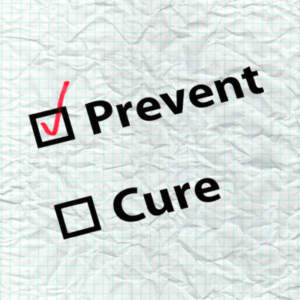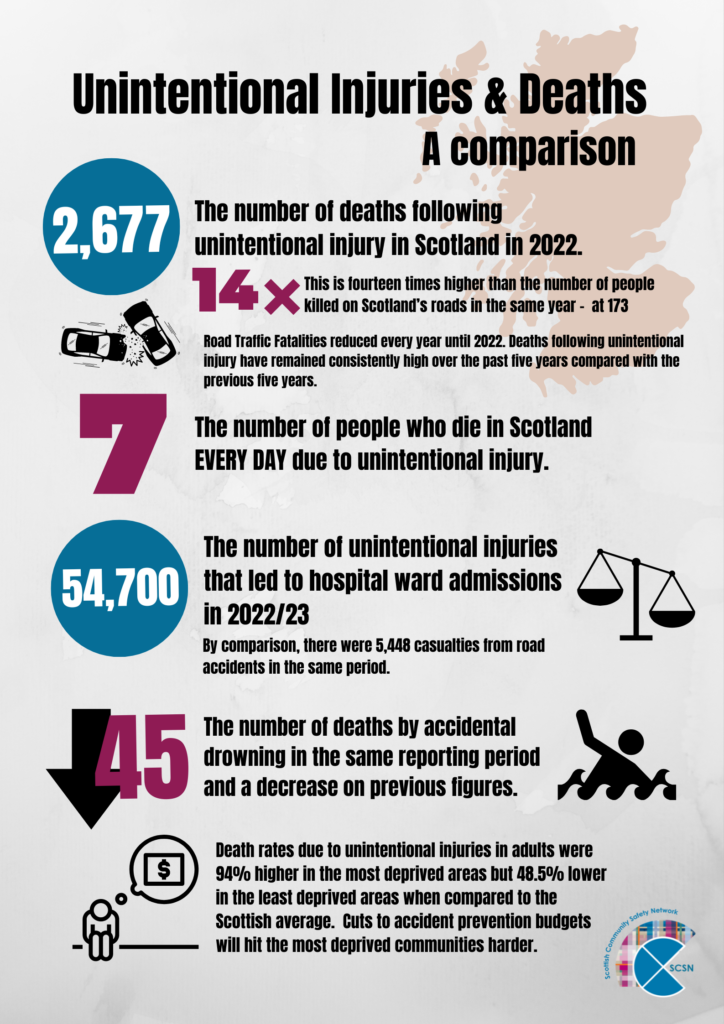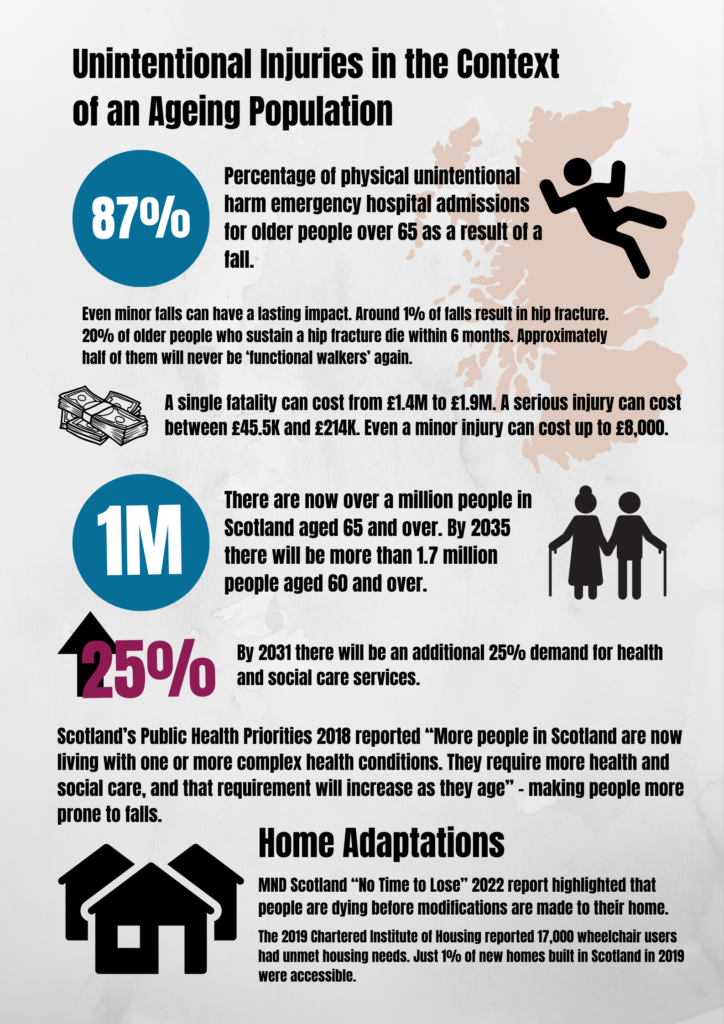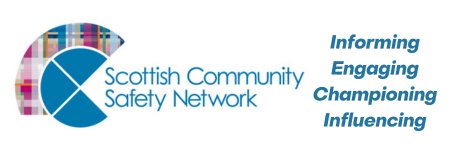by Kevin Chase, National Development Officer
The famous line used by those involved in preventative work. The origin of the phrase is not certain, however it is mainly attributed to Dutch philosopher Desiderius Erasmus, some 500 years earlier around 1500.
An organisation as reputable as the Royal College of Nursing describes prevention as the fundamental principle of modern health care, and inherent within health and social care settings across the UK. Yet as David Buck succinctly described the issue in his blog, “Prevention is better than cure – except when it comes to paying for it.”
So, what is prevention? The Oxford Dictionary describes prevention as: “The action of keeping from happening or making impossible an anticipated event or intended act.” There are different strategies of prevention delivered across governments, whether this is to prevent crime or attempts to prevent global warming, the next pandemic, the list is endless.
Now what if we turn our attention to accident prevention in Scotland. There are four areas of accident prevention; first in the workplace, governed by legislation and managed by experts in their field with Health and Safety Advisors with incidents reviewed by the Health and Safety Executive to establish if lessons need to be learned.
Second, road safety is also subject of legislative requirements via the standards of vehicles to ensure they are roadworthy. Collisions are investigated by professionals, accident “hotspots” are identified, departments review preventative work via road engineering, media awareness and road markings. There may also be partnership meetings to identify priority work in localities. The nature of road traffic collisions and legislative requirements means that the statistics are very accurate.
Third, water safety is the latest area receiving significant focus. Scotland has considerable waterways which has risks attached to it. Strategic Groups have been created to prevent deaths and injuries in our waterways. Currently led by the Scottish Fire and Rescue Service, there are innovative approaches being taken from education of young people, media awareness and signposts providing accurate descriptions of your location in case phone calls are required. (The SCSN along with other partners recently published a Water Safety Signage Audit Report submitted to the Scottish Government).
The last area of prevention is within the home space. There are some national organisations that work to prevent accidents in the home. In my role at the SCSN, I head up the Home Safety Scotland Forum – with other major national bodies in Scotland including the Royal Society for Prevention of Accidents (RoSPA) and the Child Accident Prevention Trust (CAPT).
There are some anomalies in this field of work. Firstly, they are not classed as accidents but are called “unintentional injuries”. This definition has been created by professionals, however for the average person it may not make sense. The reasoning for this is that the word “accident” suggests that such an incident was not preventable.
Secondly, and as I have previously commented on, the data picture for unintentional injuries is not reliable in that it doesn’t give us the full picture. The data we obtain is from Public Health Scotland and only records people who have had an unintentional injury that requires admission to a Ward. It does not account for Accident and Emergency treatment then release, or Scottish Ambulance Service treatment, or treatment by the local GP. Whereas the data fields in the other prevention area have highly accurate figures. Unintentional injuries provide a dip sample of statistics and the proper figures will be a lot higher than currently reported.
If we look closer at the figures, what do they tell us? Public Health Scotland’s report recorded 2,677 fatalities for unintentional injuries. This equates to seven per day. One person every 3.5 hours loses their life in Scotland because of an unintentional injury. Contrast this with road accident fatalities for the same period (173) and accidental drownings (45). For every accidental drowning we have in Scotland, there are approximately 60 deaths by an unintentional injury.
What would be the cost of this to Scotland? This is an area that needs further investigation. Currently the only data freely available is from the Strategic Needs Assessment of Unintentional Harm written by Building Safer Communities in 2017. Their estimate of financial costs was £1.6m (fatality within the home). A serious injury can cost anywhere from £45.5k (incidents within the home) to £214k (incident on the road). Even a minor injury can cost anywhere from £200 treated at a GP up to £8k treated at a hospital. These figures were based on treatment and lost days to the economy.
Now take these figures with the recent Public Health Scotland report of 2,677 fatalities at a cost of x £1.5m each, that equals £4,015,500,000 (or £4 billion). Unintentional injuries leading to admissions to wards 54709 x £100K (circa between 45.5k and 214k above) could be as much as £5,470,900,000 or £5 billion. The total cost of unintentional injuries in 2022 cost Scotland therefore could be as high as nearly £10 billion based on the Building Safer Communities statistics.
If these financial figures are shocking, what about the emotional impact of unintentional injuries? Scotland is becoming an older nation, and the average age is rising faster than the rest of the UK. If we consider, over 87% of physical unintentional harm emergency hospital admissions for adults over 65 are as the result of a fall and even a ‘minor’ fall can have a lasting impact – around 1% of falls (6,000 per year) result in hip fracture. This miserable picture is worse again with Building Safer Communities reporting in the National Strategic Assessment that 20% of older people who sustain a hip fracture die within six months; approximately half will never be ‘functional’ walkers again. Read the last sentence again and digest these facts.
What about the society impact on unintentional injuries? Scotland’s housing stock is insufficient for the ageing population. The 2019 Chartered Institute of Housing reported 17,000 wheelchair users had unmet housing needs, in addition there were a total 22,368 new homes were built in Scotland. Just over 1% were accessible, that only added 237 homes into the housing stock. This means that at the current rate, the backlog would take over 70 years to be reduced and does not consider the ageing population.
Scotland’s home adaptation process is failing people. Adaptations are created to ensure people do not suffer from unintentional injuries in their own homes. There are several flaws with the system as reported by Age Scotland and Stirling University research in 2023. What about if you know what is the most heartbreaking point with adaptations comes from the MND Scotland “No Time To Lose” 2022 report into accessible housing and adaptations for people living with MND. People and families living with MND often pass away before even their basic adaptations are installed into their property. If you link this specific issue to the findings of Public Health Scotland on people living with one or more complex health issues, it provides sufficient evidence that the national housing stock is failing the population.
Now what if I told you that the Scottish Government are planning on cutting all budgets for those who work in the field of preventing unintentional injuries in Scotland? The organisations who work in this space have been told they will not be funded for the next financial year. The reason for this is that it is no longer considered a priority by the Scottish Government. All the above statistics are likely to increase for home based unintentional injuries (especially as the current picture/dataset is not reliable) without this key prevention work. In addition to this, Public Health Scotland reported that death rates due to unintentional injuries in adults were 94% higher in the most deprived areas but 48.5% lower in the least deprived areas when compared to the Scottish average. Cuts to accident prevention budgets will hit the most deprived communities harder – increasing inequality and inequity in Scotland.
Benjamin Franklin once said, “An ounce of prevention is worth a pound of cure.” Surely this makes sense right? Scotland is getting older faster than the rest of the UK. Prevention of unintentional injuries has had its funding cut. We believe there is only one likely outcome because of this fiscal decision – more unintentional harm and accidents in Scotland.


